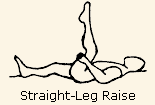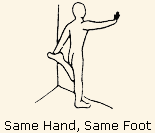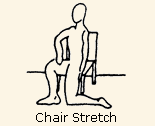Hamstrings
Straight-Leg Raise

- Lie with one leg resting on the floor and the other thigh flexed up toward the ceiling.
- Holding your thigh with your hands, slowly straighten your knee until you feel a gentle stretch along the back of your thigh (hamstrings).
- Hold 10 counts, then relax.
- Do 10-15 repetitions with each leg.

- Stand with a normal curve in the low back, midback and neck areas.
- Place one foot on a step, bench or stool, keeping the knee almost straight and foot flexed back slightly.
- Slowly lean forward until you feel a gentle stretch along the back of your thigh.
- Hold 10 counts, then relax.
- Do 10-15 repetitions with each leg.
Quadriceps
Same Hand, Same Foot

- Stand with a normal curve in the low back, midback and neck.
- Grab your ankle and pull it behind your back, until you feel a gentle stretch along the front of your thigh (quadriceps).
- DO NOT PULL THE FOOT TOWARD YOUR SEAT OR TWIST IT TO THE SIDE.
- Hold 10 counts, then relax.
- Do 10-15 repetitions with each leg.
Hip Flexors
Chair Stretch

- Kneel on one leg with the other leg straight out in front of your body.
- Keeping a normal curve in the lower back, midback and neck, slowly bend the lead leg until you feel a gentle stretch along the top, front of the thigh you are kneeling on.
- DO NOT LEAN FORWARD OR BEND THE LEAD LEG MORE THAN 90?.
- Hold 10 counts, then relax.
Ankle and Foot
Tips for Preventing Foot and Ankle Injuries
Foot and ankle injuries are common in sports, especially running, tennis and soccer. But sports enthusiasts can decrease the risk of injury by taking some precautions.
- Warm up prior to any sports activity: Lightly stretch or better yet, do a slow jog for two to three minutes to warm up the muscles. Don’t force the stretch with a “bouncing motion.”
- Condition your muscles for the sport: The amount of time spent on the activity should be increased gradually over a period of weeks to build both muscle strength and mobility. Cross training by participating in different activities can help build the muscles.
- Choose athletic shoes specifically for your foot type: People whose feet pronate or who have low arches should choose shoes that provide support in both the front of the shoe and under the arch. The heel and heel counter (back of the shoe) should be very stable. Those with a stiffer foot or high arches should choose shoes with more cushion and a softer platform. Use sport-specific shoes. Cross training shoes are an overall good choice; however, it is best to use shoes designed for the sport.
- Replace athletic shoes when the tread wears out or the heels wear down: People who run regularly should replace shoes every six months, more frequently if an avid runner. running. If you have problems with the lower legs, a dirt road is softer than asphalt, which is softer than concrete. Try to pick a good surface if possible. However, if you’re racing, be sure to train on the surface you’ll eventually run on.
- Be careful running too many hills: Running uphill is a great workout, but make sure you gradually build this up to avoid injuries. Be careful when running downhill too fast, which can often lead to more injuries than running uphills!
- Prevent recurrent injuries: Athletes who have experienced ankle injuries previously may benefit from using a brace or tape to prevent recurrent ankle injuries.
- Listen to your body: If you experience foot and ankle pain during a sport, stop the activity or modify the activity until the pain subsides. Also, if you have been injured, you should go through a period of rehabilitation and training before returning to the sport to prevent recurrent injuries.
Injury to the Achilles tendon, the strongest and largest tendon that connects the back of the calf muscle to the heel bone, occurs from overuse and is usually an acute inflammation or a partial tear. If the tendon is weak, it can rupture with the right force.
It is also common for the plantar fascia, the tough tissue that maintains the arch of the foot and runs from the heel to the toes, to become inflamed, resulting in heel or arch pain.
Runners also may experience injury to the tendons or ligaments located on the outside and inside of the ankle and stress fractures of the foot bones. In running, any one incident may not be enough to fracture the foot; however, over time, repetition of abnormal forces or stress can cause the bone to weaken or break. Five to 15 percent of all running injuries are stress fractures. Of those injuries, 49 percent occurred in those who ran between 25 miles to 44 miles per week.
Ankle injuries in soccer account for 20 to 30 percent of all soccer injuries—the most common being ankle sprains. Soccer players also may experience turf toe, a sprain that results from stubbing the toe while running or improperly planting one’s cleats.
Treatment
Treatment for these injuries varies depending on the severity of the injury. Most strains and sprains can be treated with rest, ice, compression and elevation (RICE). Moderate to severe cases, however, may require some form of immobilization such as a brace or a cast. Certain injuries that don’t heal within the expected time frame may require surgery.
It is important to seek medical attention as soon as possible for foot and ankle injuries, especially if it is causing you to limp or there is swelling. Prompt and appropriate treatment and rehabilitation ensures the best possible recovery.
Foot and ankle injuries are common in spring sports, especially running, tennis and soccer. But sports enthusiasts can decrease risk of injury by taking some precautions. Common foot and ankle injuries in spring sports include sprains, strains, and stress fractures or bone injuries. Many of these injuries are overuse injuries — injuries that result from inadequate conditioning or excessive training that places too much stress on the foot and ankle.
Running and tennis injuries include ankle sprains, Achilles tendonitis and plantar fasciitis. Ankle sprains, a partial or complete tear of any of the ligaments responsible for supporting and stabilizing the ankle joint, usually result from stepping on an uneven surface and having the foot turn awkwardly. Injury to the Achilles tendon, the strongest and largest tendon that connects the back of the calf muscle to the heel bone occurs from overuse and is usually an acute inflammation or a partial tear. It also is common for the plantar fascia, the tough tissue that maintains the arch of the foot and runs from the heel to the toes, to become inflamed, resulting in heel or arch pain.
Runners also may experience injury to the tendons or ligaments located on the outside and inside of the ankle and stress fractures of the foot bones. In running, any one incident may not be enough to fracture the foot but over time, repetition of abnormal forces or stress can cause the bone to weaken or break. Five to 15 percent of all running injuries are stress fractures. Of those injuries, 49 percent occurred in those who ran between 25 miles to 44 miles per week.
Unlike foot and ankle injuries in tennis and running, which are usually overuse injuries, soccer injuries often result from trauma such as a direct blow to the lower leg. Because soccer is a contact sport, collision injuries from striking another player are common, accounting for 30 percent of all soccer injuries.
Ankle injuries in soccer account for 20 to 30 percent of all soccer injuries — the most common being ankle sprains, he says. Soccer players also may experience turf toe, a sprain that results from stubbing the toe while running or improperly planting one’s cleats.
Treatment for these injuries varies depending on the severity of the injury. Most strains and sprains can be treated with rest, ice, compression and elevation (RICE). Moderate to severe cases, however, may require some form of immobilization such as a brace or a cast. Certain injuries that don’t heal within the expected time frame may require surgery.
It is important to seek medical attention as soon as possible for foot and ankle injuries. Prompt and appropriate treatment and rehabilitation ensures the best possible recovery.
To prevent foot and ankle injuries in spring sports, Foot & Ankle Doctors’ Office recommends the following:
Warm up prior to any sports activity. Condition your muscles for the sport. The amount of time spent on the activity should be increased gradually over a period of weeks to build both muscle strength and mobility. Stretch for at least 10 to 15 minutes before participating in the sport. Don’t use a “bouncing motion” when stretching your muscles. Rather, hold the stretch. Choose athletic shoes that specifically fit your foot type. People whose feet pronate or who have low arches should choose shoes that provide support in both the front of the shoe and under the arch. The heels also should be very stable. Those with a stiffer foot or high arches should choose shoes with more cushion and a softer platform. Use sport-specific shoes. Cross training shoes are an overall good choice, however it is best to use shoes designed for the sport. Replace athletic shoes when the tread wears out or the heels wear down. People who run regularly should replace shoes every six months, more frequently in avid runners. Avoid running or stepping on uneven surfaces. Limit running uphill. Soccer players who have experienced ankle injuries previously may benefit from using a brace or tape to prevent recurrent ankle injuries. If you experience foot and ankle pain during a sport, stop the activity or modify the activity until the pain subsides.

